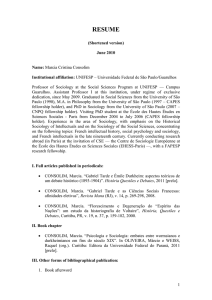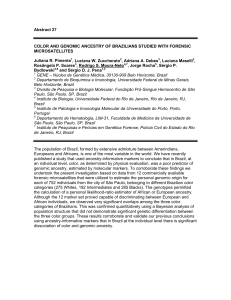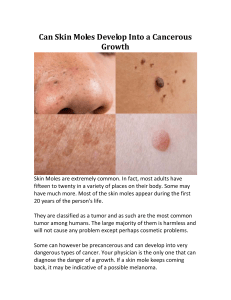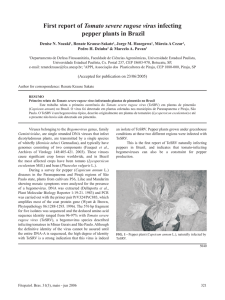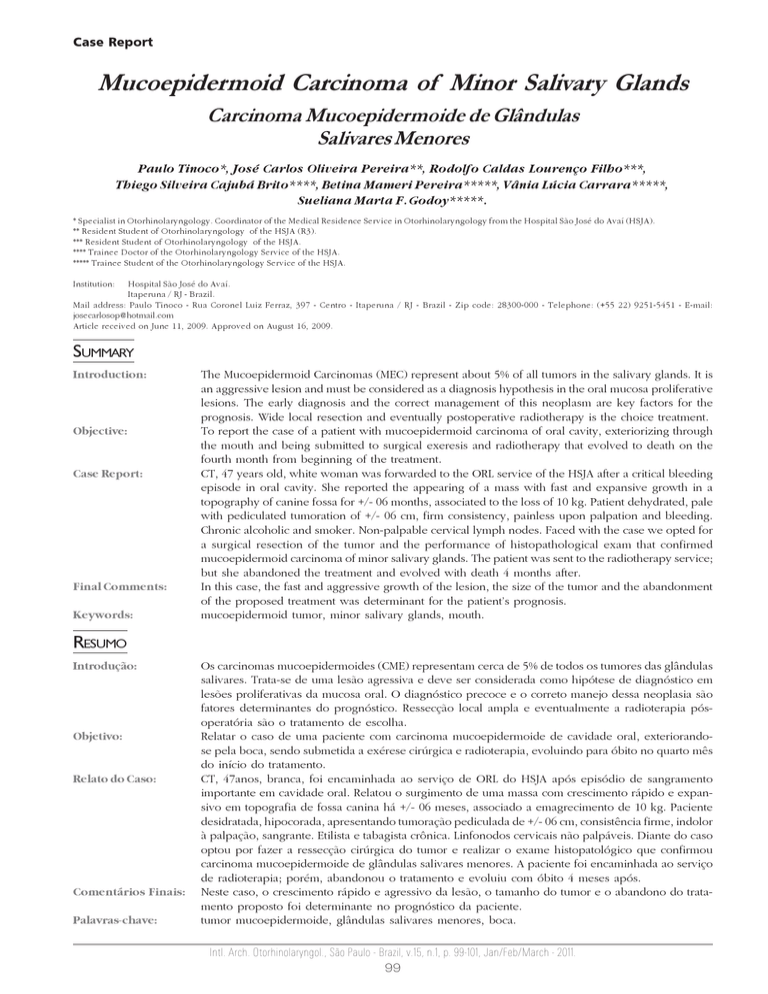
Case Report
Mucoepidermoid Carcinoma of Minor Salivary Glands
Carcinoma Mucoepidermoide de Glândulas
Salivares Menores
Paulo Tinoco*, José Carlos Oliveira Pereira**, Rodolfo Caldas Lourenço Filho***,
Thiego Silveira Cajubá Brito****, Betina Mameri Pereira*****, Vânia Lúcia Carrara*****,
Sueliana Marta F. Godoy*****.
* Specialist in Otorhinolaryngology. Coordinator of the Medical Residence Service in Otorhinolaryngology from the Hospital São José do Avaí (HSJA).
** Resident Student of Otorhinolaryngology of the HSJA (R3).
*** Resident Student of Otorhinolaryngology of the HSJA.
**** Trainee Doctor of the Otorhinolaryngology Service of the HSJA.
***** Trainee Student of the Otorhinolaryngology Service of the HSJA.
Institution:
Hospital São José do Avaí.
Itaperuna / RJ - Brazil.
Mail address: Paulo Tinoco - Rua Coronel Luiz Ferraz, 397 - Centro - Itaperuna / RJ - Brazil - Zip code: 28300-000 - Telephone: (+55 22) 9251-5451 - E-mail:
[email protected]
Article received on June 11, 2009. Approved on August 16, 2009.
SUMMARY
Introduction:
Objective:
Case Report:
Final Comments:
Keywords:
The Mucoepidermoid Carcinomas (MEC) represent about 5% of all tumors in the salivary glands. It is
an aggressive lesion and must be considered as a diagnosis hypothesis in the oral mucosa proliferative
lesions. The early diagnosis and the correct management of this neoplasm are key factors for the
prognosis. Wide local resection and eventually postoperative radiotherapy is the choice treatment.
To report the case of a patient with mucoepidermoid carcinoma of oral cavity, exteriorizing through
the mouth and being submitted to surgical exeresis and radiotherapy that evolved to death on the
fourth month from beginning of the treatment.
CT, 47 years old, white woman was forwarded to the ORL service of the HSJA after a critical bleeding
episode in oral cavity. She reported the appearing of a mass with fast and expansive growth in a
topography of canine fossa for +/- 06 months, associated to the loss of 10 kg. Patient dehydrated, pale
with pediculated tumoration of +/- 06 cm, firm consistency, painless upon palpation and bleeding.
Chronic alcoholic and smoker. Non-palpable cervical lymph nodes. Faced with the case we opted for
a surgical resection of the tumor and the performance of histopathological exam that confirmed
mucoepidermoid carcinoma of minor salivary glands. The patient was sent to the radiotherapy service;
but she abandoned the treatment and evolved with death 4 months after.
In this case, the fast and aggressive growth of the lesion, the size of the tumor and the abandonment
of the proposed treatment was determinant for the patient’s prognosis.
mucoepidermoid tumor, minor salivary glands, mouth.
RESUMO
Introdução:
Objetivo:
Relato do Caso:
Comentários Finais:
Palavras-chave:
Os carcinomas mucoepidermoides (CME) representam cerca de 5% de todos os tumores das glândulas
salivares. Trata-se de uma lesão agressiva e deve ser considerada como hipótese de diagnóstico em
lesões proliferativas da mucosa oral. O diagnóstico precoce e o correto manejo dessa neoplasia são
fatores determinantes do prognóstico. Ressecção local ampla e eventualmente a radioterapia pósoperatória são o tratamento de escolha.
Relatar o caso de uma paciente com carcinoma mucoepidermoide de cavidade oral, exteriorandose pela boca, sendo submetida a exérese cirúrgica e radioterapia, evoluindo para óbito no quarto mês
do início do tratamento.
CT, 47anos, branca, foi encaminhada ao serviço de ORL do HSJA após episódio de sangramento
importante em cavidade oral. Relatou o surgimento de uma massa com crescimento rápido e expansivo em topografia de fossa canina há +/- 06 meses, associado a emagrecimento de 10 kg. Paciente
desidratada, hipocorada, apresentando tumoração pediculada de +/- 06 cm, consistência firme, indolor
à palpação, sangrante. Etilista e tabagista crônica. Linfonodos cervicais não palpáveis. Diante do caso
optou por fazer a ressecção cirúrgica do tumor e realizar o exame histopatológico que confirmou
carcinoma mucoepidermoide de glândulas salivares menores. A paciente foi encaminhada ao serviço
de radioterapia; porém, abandonou o tratamento e evoluiu com óbito 4 meses após.
Neste caso, o crescimento rápido e agressivo da lesão, o tamanho do tumor e o abandono do tratamento proposto foi determinante no prognóstico da paciente.
tumor mucoepidermoide, glândulas salivares menores, boca.
Intl. Arch. Otorhinolaryngol., São Paulo - Brazil, v.15, n.1, p. 99-101, Jan/Feb/March - 2011.
99
Mucoepidermoid carcinoma of minor salivary glands.
Tinoco et al.
INTRODUCTION
The Mucoepidermoid Carcinomas (MEC) represent
about 5% of all tumors in the salivary glands. They affect
the intraoral major and minor salivary glands in more than
90% of the cases (1, 2). In the minor salivary glands it
affects specifically the roof and the floor of the mouth,
generally in the fifth decade of life and with a slight
prevalence in the female sex. The mucoepidermoid
carcinomas have been histologically classified into three
degrees of malignity (low, intermediate and high degree),
and such subdivision has been proved helpful for the
setting up of the therapy and in the prognosis of such
tumors (3, 4, 5). The early diagnosis and the correct
management of this disease are key factors for the
prognosis. It is an aggressive lesion and must be considered
as a diagnosis hypothesis in the oral mucosa proliferative
lesions, even when its clinical appearance does not
suggest malignity.
Figure 1. Pediculated tumor in oral cavity.
CASE REPORT
CT, 47 years old, white housewife from Italva/RJ,
was forwarded to the ORL service of the HSJA after a critical
episode of bleeding in oral cavity. She reported the
appearing of a mass with fast and expansive growth in a
topography of canine fossa for +/- 06 months, associated
to the loss of 10 kg. The patient was lucid, examined, with
regular general status, dehydrated (++/+4), pale (++/+4),
with pediculated tumor of +/- 06 cm (Figure 1), firm
consistency, painless with palpation, bleeding; non-palpable
cervical lymph nodes. Chronic alcoholic and smoker, without
family record of neoplasm. Faced with the case we opted
for a surgical resection of the tumor (Figure 2) and the
performance of histopathological exam that confirmed
mucoepidermoid carcinoma of minor salivary glands of
intermediate degree (Figure 3). The patient was sent to
the radiotherapy service; but she abandoned the treatment
and evolved with death 4 months after.
Figure 2. Surgical piece.
DISCUSSION
Mucoepidermoid carcinomas (MECs) are malignant
tumors from glandular structures excrectory ducts that
affect the intraoral major and minor salivary glands in more
than 90% of the cases (1, 2). MEC can also occur in covering
glands of the maxillary sinuses, lachrymal glands,
oropharynx, nasopharynx, larynx, vocal cords, trachea and
lungs (2).
The etiopathogenesis of the MEC is unknown;
however, as well as the other kinds of cancer, the lesion
Figure 3. Optical microscopy exam of the mucoepidermoid
carcinoma of minor salivary glands. Microscopy (HE 100 x).
results from genetic alteration, and when altered the protooncogenes and the tumor suppressor genes play an
important role in their pathogenesis. As procatartic factors
we include exposure to ionizing radiation, previous RT,
Intl. Arch. Otorhinolaryngol., São Paulo - Brazil, v.15, n.1, p. 99-101, Jan/Feb/March - 2011.
100
Mucoepidermoid carcinoma of minor salivary glands.
nickel refinery, chemical solvents, leather, sawing,
formaldehyde, pollution (9). The MEC’s histopathological
characteristics are: presence of squamous cells, mucusproducing cells and intermediate cells. The predominant
cellular type and its configuration vary between the tumors
and inside the same tumor mass.
Clinically, MEC may manifest as a lesion of color
ranging from blue to red or purple. The oral mucosa
lesions, floor of the mouth, lips and retromolar region
appear as asymptomatic submucous masses while tongue
lesions are frequently painful. The factors relating to the
MEC prognosis are: size of the primary lesion upon
surgery, histological grading of the tumor and presence of
metastases.
Large local resection associated or not to cervical
space and eventually postoperative radiotherapy is the
choice treatment for mucoepidermoid carcinomas (1, 5, 6,
7, 8). The resection of adjacent structures is indicated for
cases with complications detected previously or during the
surgery.
FINAL COMMENTS
Such tumors have different biological behavior
according to the degree of histological differentiation, size
of the lesion and presence of metastases; the early diagnosis
and the correct management are key factors for prognosis.
In this case, the fast and aggressive growth of the
lesion, the size of the tumor was critical for the patient’s
prognosis.
BIBLIOGRAPHICAL REFERENCES
1. Ellis GL, Auclair PL, Gnepp DR. Surgical Pathology of the
salivary glands. Major Problems in Pathology Series. Volume
25. Philadelphia: WB Saunders Company; 1991.
Tinoco et al.
2. Ellis GL, Auclair PL. Tumors of the Salivary Glands. In:
Armed Forces Institute of Pathology. Atlas of Tumor
Pathology. 3rd Series, Fascicle 17. Washington; 1996.
3. Auclair PL, Goode RK, Ellis GL. Mucoepidermoid
carcinoma of intraoral salivary glands. Cancer. 1992, 69:202130.
4. Cardoso WP, Denardin OV, Rapoport A, Araújo VC,
Carvalho MB. Proliferating cell nuclear antigen expression
in mucoepidermoid carcinoma of salivary glands. São Paulo
Med J. 2000, 118:69-74.
5. Goode RK, Auclair PL, Ellis GL. Mucoepidermoid
carcinoma of the major salivary glands: clinical and
histopathologic analysis of 234 cases with evaluation of
grading criteria. Cancer. 1998, 82:1217-24.
6. Brandwein MS, Ivanov K, Wallace DI, Hille JJ, Wang B,
Fahmy A, Bodian C, Urken ML, Gnepp DR, Huvos A,
Lumerman H, Mills SE. Mucoepidermoid carcinoma: a
clinicopathologic study of 80 patients with special reference
to histological grading. Am J Surg Pathol. 2001, 25:835-45.
7. Plambeck K, Friedrich RE, Bahlo M, Bartel-Friedrich S,
Klapdor R. TNM staging, histopathological grading, and
tumor-associated antigens in patients with a history of
mucoepidermoid carcinoma of the salivary glands.
Anticancer Res. 1999, 19:2397-404.
8. Spiro RH, Huvos AG, Berk R, Strong EW. Mucoepidermoid
carcinoma of salivary gland origin: a clinicopathologic study
of 367 cases. Am J Surg. 1978, 136:461-8.
9. Calderón-Garcidueñas L, Delgado R, CalderónGarcidueñas A, Meneses A, Ruiz LM, Garza J, Acuna H,
Villarreal- Calderón A, Raab-Traub N, Devlin R. Malignant
neoplasms of the nasal cavity and paranasal sinuses: A series
of 256 patients in México City and Monterrey. Is air pollution
the missing link? Otolaryngol Head Neck Surg. Apr. 2000,
122:499-508.
Intl. Arch. Otorhinolaryngol., São Paulo - Brazil, v.15, n.1, p. 99-101, Jan/Feb/March - 2011.
101






